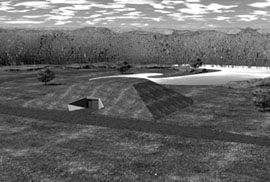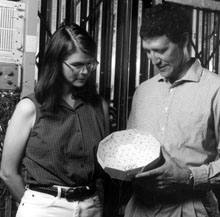 |
|
For the MiniBooNE Detector:The Teletubby Design
by Sharon Butler Since the last installment in our series on the fledgling MiniBooNE experiment, physicists have been busy hawking their research proposal to the Department of Energy and the National Science Foundation. Both agencies promptly committed funds, and one mysterious well-wisher in New York City even sent in a $40 check.With money nearly in hand, the MiniBooNE scientists and engineers set to work six months ago on the final design for their detector and began pulling together a bid package for its construction. Their goal was to have construction underway before the end of the fiscal year. As it turned out, babysitting duty proved invaluable experience in the detector's design.
The electronics started out in classic Fermilab-issue portakamps, and gradually migrated closer to the hole-in-the-ground with each iteration of the detector's design. Finally, the engineers thought they had the solution. Build a T-shaped structure above ground, extended from the top of the tank. The space was cramped, but it seemed to work. Until ...a "value engineering" meeting brought in outside experts to weigh in on the problem. Value engineering is a practice associate director George Robertson has been pushing at the Laboratory. For the meeting, facilitated by the Army Corps of Engineers, 25 people were stuffed into a room at Fermilab: members of the MiniBooNE collaboration, Fermilab's own experts in architectural, structural, civil, mechanical and electrical engineering, consultants from Crawford, Murphy, and Tillyˇand, critically, a few retired engineers from Fermilab, including Tom Pawlak. Jeff Sims, design coordinator for the project in Fermilab's Facilities and Engineering Services Section, walked everyone through the project and the design specifications. Then, as is customary in value engineering exercises, the group broke into a freewheeling brainstorming session, throwing out ideas, one on top of another, until the well was dry. They picked through the ideas: Out of 60, 20 seemed workableˇand, in the end, 15 were incorporated into the final design. Throughout the entire discussion, Sims said, Pawlak was "pretty quiet." But at the end of the first intense day, Pawlak, who had been babysitting his grandchildren, pulled Sims aside. "I have an idea I'd call the `Teletubby' concept. I'll fax you my thoughts." Sims, who has a one-year-old son, knew immediately what Pawlak was referring to. Forget the T-shaped structure for all the electronics. Just as Teletubbies romp about on a mound of earth, emerging from a big circular playroom underground, so, Pawlak was proposing, the MiniBooNE experimenters could build a circular electronics room under a mound of earth right on top of their detector. That would give the scientists a huge open space in which to place their electronics, with cabling easily threading through the floor directly into the pre-amplifiers instead of streaming down a corridor. To create the room, they just needed to extend upwards the cylindrical retaining walls around the detector and lay a concrete floor. The new design would save both time and money. "It was a big moment in the evolution of the detector's design," said Rex Tayloe, of Los Alamos National Laboratory, who has been managing the project along with Fermilab physicist Peter Kasper. "Structurally and architecturally," said Sims, "it was a better solution than the T-shaped building." CMT worked feverishly to draw up the new plans and specs. The bid package went out on July 29, 1999, meeting the schedule the scientists had set well over a year ago. The package is a monstrous document, "pure drudgery" to review, Tayloe said. Some 40 drawings on giant sheets of white paper lay out the detector from every angle. A five-pound book specifies the properties and dimensions for every conceivable item: the sizes, types, and colors of electrical wires; the strength of the concrete; the temperature (200 degrees Fahrenheit) and length of time (24 hours) to cure the paint inside the detector (so that solvent organic compounds don't leach into the mineral oil). The tank and the civil construction are expected to cost about $1.5 million.
Bill Louis, cospokesperson for the MiniBooNE experiment, praised the FESS and Business Services staff for their help in getting out the bid package: "People at Fermilab are not only good and talented; they are willing to help; they want to get things done." He described the new and final design for the detector as "efficient and [Teletubbies notwithstanding] elegant."
Of course, he added without missing a beat, Fermilab deserves elegance.
Protoype of a phototube for the MiniBooNE detector.
|
| last modified 9/3/1999 email Fermilab |
FRLsDFx9eyfrPXgV


